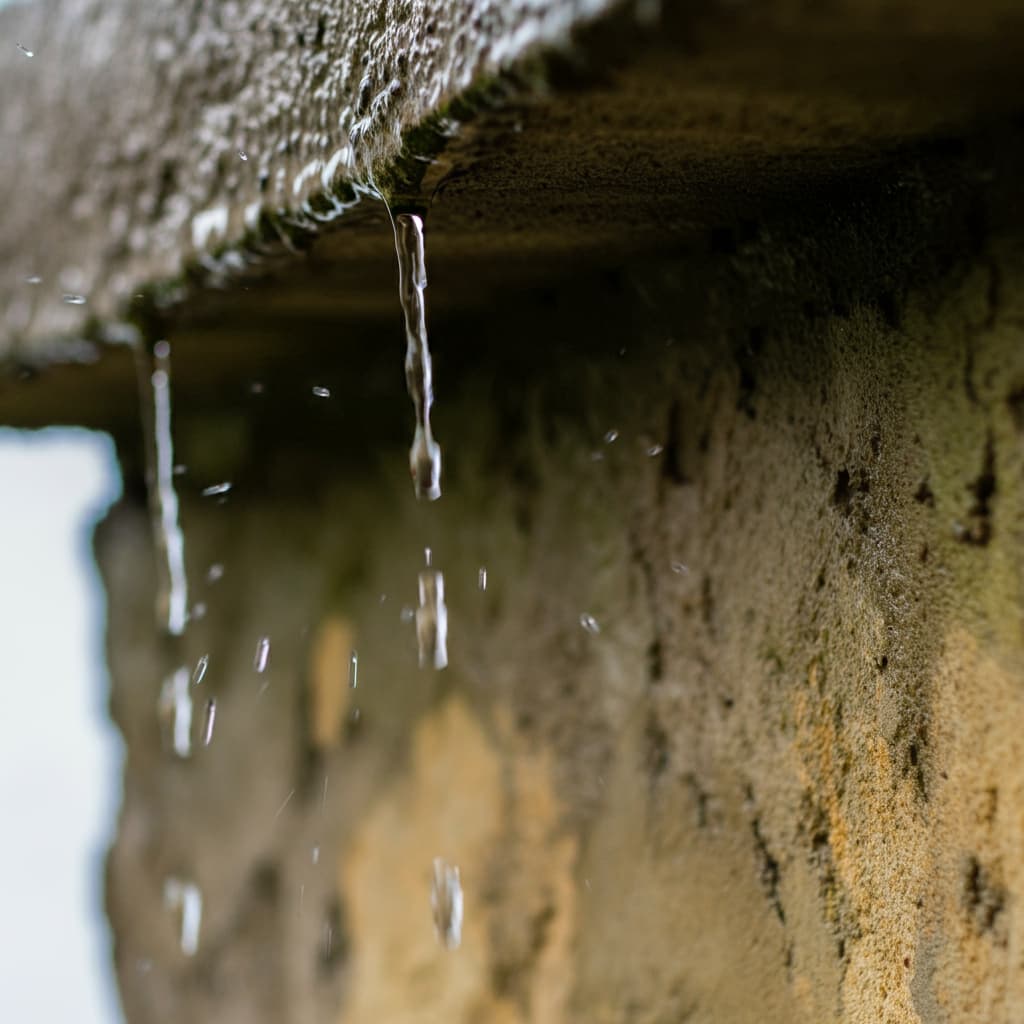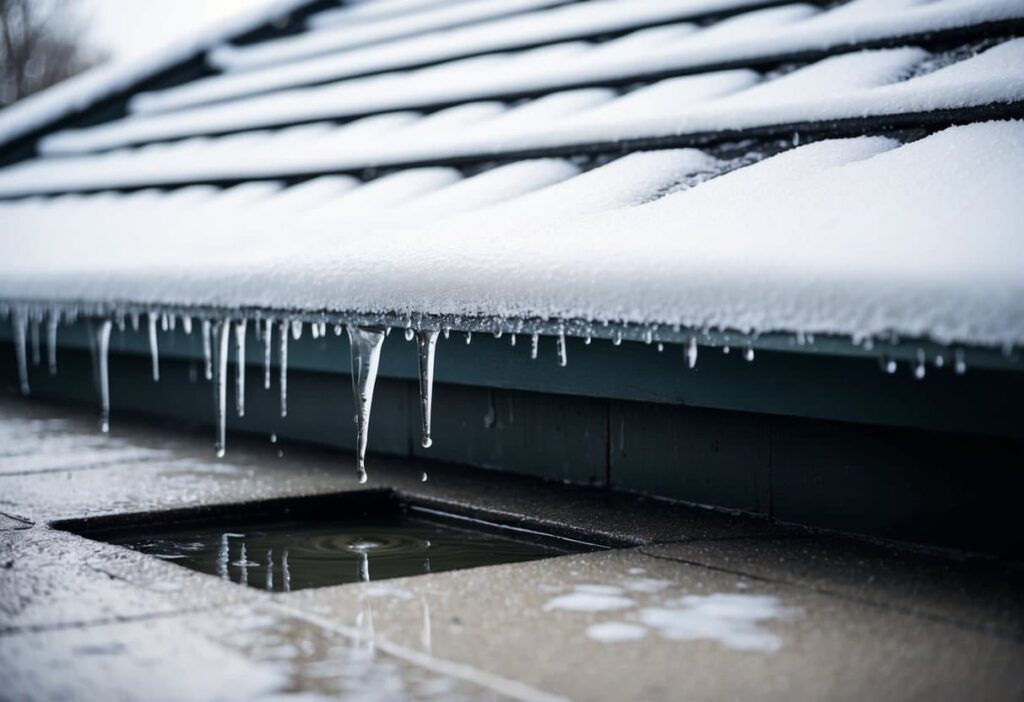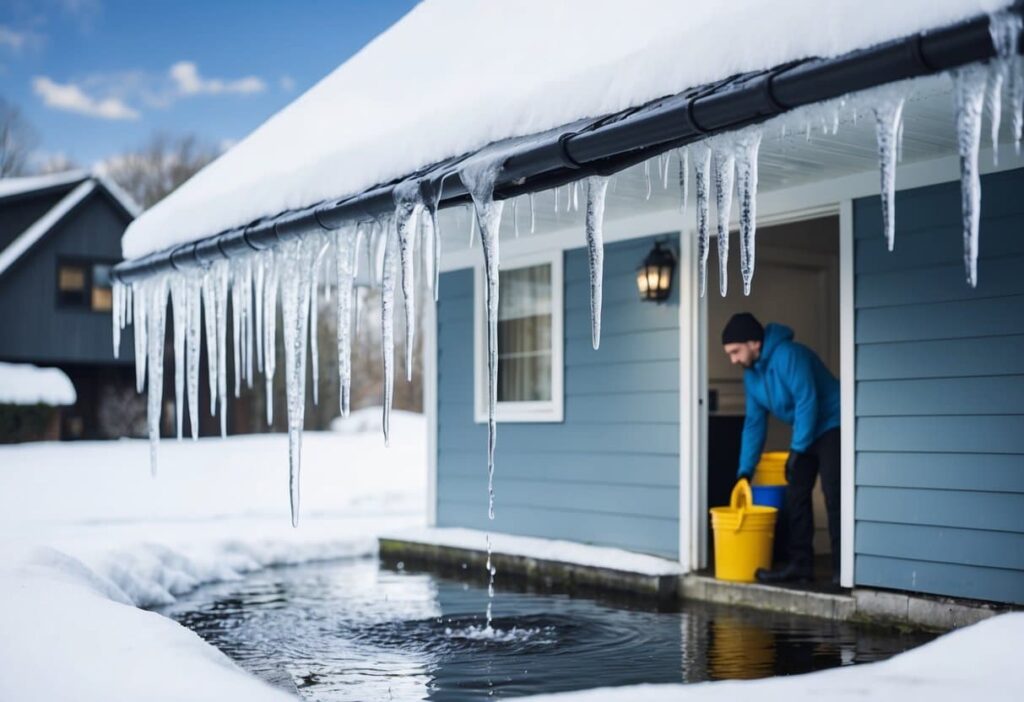Roof Leaking in Winter: Cold Weather Repair Tips
Cold Weather can bring serious problems for homeowners, and a roof leaking in winter tops the list. Cold temperatures, snow, and ice dams put extra strain on roofs. This often leads to cracks and gaps where water seeps in.

A leaking roof in winter can cause major damage to a home’s structure, insulation, and interior finishes if not fixed quickly. The first signs are often water stains on ceilings or walls. Homeowners may also notice drips coming from light fixtures or vents.
Roofing in winter is tricky. Snow and ice make repairs dangerous. It’s best to call a pro roofer for a thorough inspection and repair plan. They can find the source of leaks and patch them safely. Proper maintenance before winter hits is key to avoiding leaks in the first place.
Everything You Need to Know About Winter Roof Leaks
Roof leaks can be a big problem in winter. Cold weather puts extra stress on roofs and can cause damage.
Ice dams are a common issue. They form when heat escapes through the roof, melting snow. The water then refreezes at the edges, creating a dam. This traps water that can seep under shingles.
Clogged gutters also lead to trouble. Water can’t flow properly when they’re full of leaves and debris. It may back up and get under roofing materials.
Damaged shingles are another culprit. The freeze-thaw cycle can crack or loosen them. This creates openings for water to enter.
Poor ventilation and insulation play a role too. They can cause uneven roof temperatures. This leads to ice dams and other issues.
Here are some key causes of winter roof leaks:
- Ice dams
- Clogged gutters
- Damaged shingles
- Poor ventilation
- Inadequate insulation
- Heavy snow loads
- Wind damage
Regular roof checks and maintenance can help prevent these problems. It’s best to address issues before the cold weather hits.
Preventative Measures
Taking steps to protect your roof can save you from costly repairs and water damage. Regular upkeep and smart choices make a big difference in keeping your home dry.
Regular Inspections and Maintenance
Check your roof twice a year, in spring and fall. Look for missing or damaged shingles, cracks, and soft spots. Fix small issues right away to stop them from getting worse. Clean off leaves, branches, and other debris that can trap moisture.
Trim tree branches near your roof to stop them from rubbing and damaging shingles. Replace worn-out flashing around chimneys and vents. Seal any gaps or cracks with roof cement or caulk.
A pro roofer can spot problems you might miss. It’s smart to get a yearly roof check-up from an expert.
Gutter Maintenance
Clean gutters are key to stopping winter roof leaks. Clear out leaves, twigs, and gunk at least twice a year. Use a sturdy ladder and rubber gloves for safety.
Check that gutters slope towards downspouts. Water should flow freely away from your home. Fix any sagging or loose sections.
Install gutter guards to keep out debris. This cuts down on cleaning and helps water flow better. Make sure downspouts extend at least 5 feet from your house to avoid water pooling near the foundation.
In cold areas, think about heated gutter cables. These melt ice and stop dangerous ice dams from forming.
Proper Insulation and Ventilation
Good attic insulation keeps your roof deck cold in winter. This stops ice dams that can lead to leaks. Check your attic insulation levels and add more if needed.
Proper airflow is just as vital. Install roof vents and soffit vents to let out hot, damp air. This keeps your attic dry and your roof in good shape.
Make sure bathroom and kitchen exhaust fans vent outside, not into the attic. Too much moisture in the attic can cause mould and rot in roof beams.
Check that attic insulation doesn’t block soffit vents. Keep a clear air path from the soffits to the roof peak. This helps your roof stay dry and strong all year round.
Diagnosing the Issue

Finding the source of a roof leak in winter requires careful inspection and an understanding of common problem areas. Identifying signs of damage and potential causes helps pinpoint the issue.
Recognizing Signs of Damage
Look for water stains on ceilings or walls. These often appear as brown or yellowish patches. Check the attic for damp spots or mould growth. Peeling paint or bubbling wallpaper can also signal a leak.
Outside, scan for missing or damaged shingles. Cracked or curled shingles may let water in. Inspect metal flashing around chimneys and vents for cracks or gaps. Large icicles hanging from gutters might mean ice dams are forming.
In the attic, look for wet insulation or water droplets on the underside of the roof. Condensation can sometimes be mistaken for a leak, so proper airflow is key.
Identifying Potential Causes
Winter roof leaks often stem from ice dams. These form when heat escapes through the roof, melting snow. The water then refreezes at the roof’s edge, creating a dam. This can force water under shingles and into the home.
Damaged or missing shingles are another common culprit. High winds or heavy snow can loosen or break shingles, letting water seep in. Cracked flashing around chimneys, vents, or skylights can also cause leaks.
Poor attic insulation or ventilation can lead to condensation issues. This moisture can drip down, mimicking a leak. Clogged gutters may cause water to back up and seep under shingles.
Repairing Your Roof in Winter

Fixing a leaky roof in cold weather is tricky but important. Quick action can prevent further damage and costly repairs.
Handling Minor Repairs
For small leaks, use roofing cement to patch holes or cracks. Apply it with a putty knife on dry surfaces above 4°C. Seal gaps around vents and chimneys with caulk designed for cold temps.
Replace damaged shingles carefully. Lift the edges of nearby shingles and remove nails. Slide out the bad shingle and put a new one in its place. Nail it down and seal the edges.
Clear ice dams with calcium chloride in a nylon stocking. Place it on the roof edge to melt channels for water drainage. Don’t use salt, as it can harm roofing materials.
Professional Solutions
For big leaks or unsafe conditions, call a pro. They have the tools and know-how for winter fixes. Roofers can work in cold weather using special techniques.
Pros can fully assess the damage and spot hidden issues. They may use infrared tools to find wet spots under the roof surface. This helps target repairs and avoid bigger problems later.
Some repairs may need to wait for warmer weather. In these cases, a pro can set up temp fixes to get you through winter. They might use tarps or emergency patches until a full repair is possible.
Long-Term Solutions

Fixing roof leaks for good takes careful planning. The right materials and proper insulation are key to keeping your home dry and warm.
Choosing the Right Roofing Materials
Picking tough roofing materials is crucial for long-lasting protection. Metal roofs can last 50+ years and resist ice dams. Slate tiles are pricey but can last a century. Asphalt shingles are budget-friendly and last 20-30 years with proper care.
Look for materials rated for your climate. In snowy areas, choose products with high ratings for ice and water shields. Some roofing comes with extra UV protection to prevent sun damage.
Don’t forget about colour. Darker roofs absorb more heat, which can melt snow faster. This might sound good, but it can lead to ice dams. Lighter colours reflect heat and may be better in cold climates.
Ensuring Adequate Attic Insulation
Good attic insulation keeps your home cozy and your roof in top shape. It stops heat from escaping, which prevents ice dams and icicles.
Measure your current insulation depth. Most homes need 16-20 inches of insulation for proper coverage. If you can see your ceiling joists, you need more insulation.
Choose the right type of insulation. Blown-in cellulose or fibreglass works well and can be added on top of existing insulation. Foam insulation sprays into small gaps for a tight seal.
Don’t forget about air sealing. Seal gaps around pipes, vents, and wires before adding insulation. This stops warm, moist air from reaching your cold roof and causing ice dams.
Proper ventilation is just as important as insulation. Install soffit and ridge vents to keep air flowing. This helps control moisture and temperature in your attic space.
Preparing for Winter Weather

Winter brings harsh conditions that can damage roofs. Taking steps to protect your roof is key to preventing leaks and costly repairs.
Winterizing Your Roof
Check your roof for loose or damaged shingles before cold weather hits. Replace any worn shingles and secure loose ones. Seal gaps around vents and chimneys with caulk to stop water from seeping in.
Add extra insulation to your attic. This helps prevent ice dams by keeping the roof surface cold. Make sure your attic has proper ventilation too.
Trim tree branches that hang over your roof. Heavy snow can cause them to break and damage shingles.
Install heat cables along the roof edge and in the gutters. These melt snow and ice to prevent buildup.
Upkeep and Care During the Cold Months
Remove snow from your roof after heavy storms. Use a roof rake with an extendable handle to safely clear snow from the ground.
Keep an eye out for ice dams forming along the roof edge. Break them up carefully with an ice pick if needed.
Clean your gutters before winter and check them regularly. Clogged gutters can lead to ice dams and water backing up under shingles.
Look for signs of leaks inside, like water stains on ceilings. Address any issues right away to prevent further damage.
Have a pro inspect your roof each spring and fall. They can spot potential problems early on.
When to Consult a Professional
Roof leaks in winter can be tricky to handle on your own. It’s smart to call one of our C.D. Roofing contractors when the problem seems complex or dangerous.
If you notice large wet spots on your ceiling or walls, it’s time for expert help. These signs often mean the leak has been going on for a while.
Safety should be your top priority. Icy or snow-covered roofs are very slippery. Let the pros handle repairs in these risky conditions.
Some issues that need professional attention include:
• Damaged or missing shingles • Ice dams along the roof edge • Cracks or holes in the roofing material • Blocked or broken gutters
A roof inspection by one of our experts can find hidden problems. They have tools and know-how to spot issues you might miss.
Roof repair isn’t always a DIY job. Our skilled roofers can fix leaks properly and prevent future damage. They also know the right materials for your climate.
If your roof is old or has had many repairs, it might be time for roof replacement. Our pros can tell you if this is needed and give you options.
Don’t wait too long to get help. Small leaks can turn into big, costly problems if left alone. Quick action can save you money in the long run.
Frequently Asked Questions
Roof leaks in winter can cause major headaches for homeowners. These common questions address key issues around causes, repairs, prevention, and identifying leaks during cold weather.
What are the common causes of ceiling leakage during the winter season?
Ice dams are a frequent culprit of winter roof leaks. They form when heat escapes through the roof, melting snow that refreezes at the eaves. This creates a barrier that traps water.
Damaged or missing shingles can also lead to leaks. High winds and heavy snow can loosen or tear off shingles, leaving the roof vulnerable.
Clogged gutters are another common cause. When gutters fill with leaves and debris, water can back up under shingles and seep into the home.
How can you repair a leaky roof in the midst of winter?
Temporary fixes can help until a full repair is possible. Applying roof tar or a patch to the leak area from inside the attic can stop water entry for a short time.
For accessible exterior leaks, roofing cement can seal gaps around flashing or shingles. This creates a water-tight barrier in freezing temps.
In severe cases, a tarp over the affected area can prevent further water damage until conditions allow for proper repairs.
What steps should be taken to prevent a roof from leaking when it snows?
Proper insulation and ventilation in the attic help prevent ice dams. This keeps the roof surface cold, stopping snow melt and refreezing at the eaves.
Clearing gutters before winter ensures proper drainage. This stops water from backing up under shingles when snow melts.
Installing heat cables along the roof edge can melt snow and ice. This creates channels for water to flow off the roof safely.
Is it common for roofs to experience leaks during periods of heavy rainfall?
Heavy rain can expose weak spots in a roof. Areas with damaged or missing shingles are prone to leaks during downpours.
Flashing around chimneys, vents, and skylights can deteriorate over time. This allows water to seep in during intense rainfall.
Roofs past their lifespan may develop leaks in heavy rain. Aging materials become less water-resistant and more prone to failure.
What are the risks of a metal roof developing leaks in cold weather?
Improperly installed metal roofs can leak at the seams. Extreme temperature changes cause expansion and contraction, potentially creating gaps.
Fasteners may loosen over time due to thermal movement. This can create entry points for water, especially during freeze-thaw cycles.
Ice dams can still form on metal roofs if attic insulation is poor. This traps water that can find its way under the metal panels.
How does one identify the source of a winter roof leak?
Water stains on ceilings or walls often indicate a leak. The source may be directly above or travel along rafters before becoming visible.
Inspect the attic during daylight for signs of water entry. Look for wet insulation, damp wood, or light shining through the roof.
Check for ice dams along the roof edge. These are a common source of winter leaks and may be visible from the ground.
